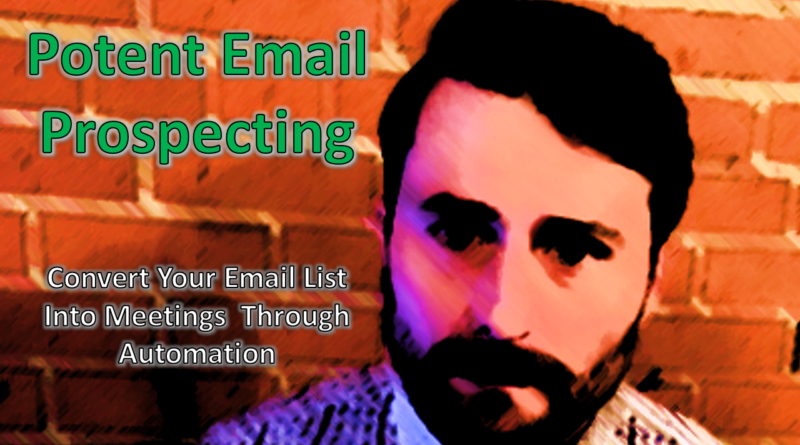Automated Prospecting That Works
Automated Cold-Emails That Really Work
Over the last few years I’ve generated millions of dollars in revenue and a big contributor to that has been building rapport and personal connections with my customers through interacting with them over the phone and in-person.
I’m a big proponent of cold calling in-person and over the phone as a first point of contact with potential customers. Especially if you’re new to sales or targeting a market sector/demographic you’ve never sold to before. The one-to-one communication of conventional prospecting gives you as the seller real-time feedback on whether your message is landing with a potential customer. If it’s not, you can change your approach on the fly.
As you continue to grow your business however, cold-calling new prospects individually just isn’t an efficient use of time. It can often take a number of calls, 3-4 is my average, before you even move a prospect to the first real stage of your sales process where building rapport and personal connection is a must (i.e. the discovery and lead qualifying stage). In some cases it takes 3-4 calls just to find out you’ve been trying to connect with the wrong person at the organization you targeted.
Of course, once you’ve been able to identify what your ideal client looks like and dial in on the word tracks that convert, you should be able to start automating early stages of your sales processes. Namely the prospecting activities. Doing so will save you a ton of man-hours without killing your rapport building opportunities or conversation rate.
In fact, automated prospecting it is likely to free you up to better nurture your relationships with qualified leads.
So, when and where can we automate?
Like I’ve mentioned – and maybe you can relate – I often make 3-4 cold-calls to a prospect before actually connecting with them. (And – yes I still make cold-calls. Cold-calling will likely always be a part of my marketing activities.) Making follow-up call after follow-up call isn’t hard. It can be mind numbing and time consuming however.
Another challenge I have is a long list of email subscribers, but no phone numbers I can use to engage them in a legitimate sales conversation.
What if I told you I’ve developed a way to:
1. Dramatically decrease your time spent cold-calling.
I used to manually dial 80 – 100 calls a day. Now I make less than 10.
2. Get email subscribers to book their own discovery calls.
I went from not having their phone number to having them schedule a sales call days in advance. Now a lot of prospects call me, instead of me having to call them.
Well, here it is…
Automated Prospecting That Works
How I Convert My Email List into Meetings with Buyers
Right now my favorite system for automating sales and prospecting emails is Streak CRM. It super easy to use, it keeps your sales process organized, and it’s free for individual salespeople or solopreneurs to use.
Stream CRM won’t replace your need for an email service provider like MailChimp, ConvertKit, etc. for on-going drip campaigns. Streak CRM is more appropriate for automating small batches of semi-customized prospecting emails that engage your prospects in a buying process.
Because Streak CRM works as a Google Chrome extension over your Gmail inbox, the number of emails you can send at once will ultimately be limited by Gmail’s daily outbound email restrictions.
Similar to email service providers like MailChimp, ConvertKit, etc. you can auto-populate fields within templated emails you send using Streak CRM. With this feature you can have things like a prospect’s name, the last time they emailed you, the last time you emailed them, and the content you’ve already sent them referenced in the email to help better engage them with your message.
Not only will you have personalization working for you to increase the likelihood your emails gets opened and responded to, but because Streak CRM works over Gmail your emails will look to your recipients as if you took the time to individually write them the message.
Batched emails sent through Streak CRM don’t look like mass emails sent from MailChimp, ConvertKit, etc., they look like regular emails. Not only can email providers like Gmail, Yahoo, and everyone else identify and filter mass emails from MailChimp, ConvertKit, etc. to a spam or promotions folder, your prospects can identify most mass mailing from a mile away as well.
In the off chance a cold-email from a big ESPs actually lands in their inbox, they might not be getting read. A lot of your messages might also get marked as spam which could give you problems with your ESP.
Emails from Streak CRM however – emails that look individually written – are much more likely to be opened, read, and responded to.
Getting Started with Streak CRM
If you have a list of leads that includes your prospects’ first names and email addresses you’re off to good start. If you don’t have a list like that, create one in Excel, Google Sheets, or some other CSV platform.
Trouble Finding Prospects to Target?
Check Out My FREE Sales Mastery Mini-Course
Better Leads. Bigger Deals.
Once you’ve installed the Streak CRM extension for Chrome, customize the column heading so that there is one for each piece of information you want to track.
At the very least, there should be a column heading in Streak CRM to match each of the column headings represented in the CSV (Excel, Google Sheets, etc.) file you want to import.
After you’ve set up the column headings to include all of the customer data you want to track or auto-populated in your email templates, go ahead and import your leads into Streak CRM from your CSV file.
Streak CRM refers to the sum of all stages that make up your sales process as a pipeline. Give each stage an appropriate name so that you don’t forget what has and hasn’t been communicated to your prospective clients.
For the purposes of this tutorial we’re only concerned with stages leading up to an intro/discovery call, first-meeting, or product demo. To reach this point in your sales process I suggest a four email sequence.
That sequence includes your initial pitch on why a prospect should schedule an appointment with you and three follow-up messages. Each follow-up message should trail its predecessor by two to three business days unless your prospect contacts you first.
If your receive a reply to a pitch or follow-up email move that prospect to the discovery/demo stage of your pipeline. Prospects that reply to any one of your emails don’t need to receive the remaining follow-up messages.

Keep it simple by naming the first five stages as follows:
Lead: This is where new and unworked prospects start in the pipeline.
First Email Sent: Prospects are moved to this stage once they’ve been included in a mail merge – batched email – that distributes your initial pitch.
Follow-Up #1 Sent: Prospects are moved to this stage once they’ve been included in a mail merge that distributes your first follow-up message.
Follow-Up #2 Sent: Prospects are moved to this stage once they’ve been included in a mail merge that distributes your second follow-up message.
Follow-Up #3 Sent: Prospects are moved to this stage once they’ve been included in a mail merge that distributes your third follow-up message.
The 4 Message Email Sequence
Email #1: Initial Pitch
As with any prospecting email, your initial pitch should be as a short as possible. This email does however, need to establish who you are, what problem you can solve for the prospect, and a compelling reason your prospect should schedule an appointment with you.
As a first point of contact with your prospect, this message should not be asking them to do business with you. That would be like walking across a bar and asking a stranger to marry you. Don’t be that person.
There should not be any pricing information in this email either.
The goal of this first email is to schedule a first-meeting or discovery call. The goal of this email is not to close your client, so don’t get ahead of yourself by asking for their businesses too quickly. The purpose of this email is to find out when their schedule allows for you two to have your first real conversation.
____
____
Email #2: Circle Back and Make Their Life Easier [Follow-Up #1]
In the days when I used this formula by manually writing follow-up emails I would write follow-up messages as a reply to my previous email. For that reason the follow-up email could be very short. It could also refer to the information in previous messages without having to restate the information in its entirety.
In the interest of efficiency and the theme of this tutorial, I’ll show you how to simulate this through Streak CRM in just a little bit. That way you won’t have to manually follow-up with anyone in these early stages of your sales process.
The goal of the first follow-up is to bring attention to your first message. People are busy and sometimes it requires pinging them a few times simply to get on their radar.
It might also help your cause to make scheduling a meeting easier on your prospect. Some people may be hesitant to book a meeting with you simply because they don’t have time to compare schedules with you. By suggesting a time for the meeting you’ll dramatically make your prospect’s life easier.
You can take this one step further by offering your prospect a link to your Calendly, so that in the event your suggested meeting time doesn’t work for them, they can pick another time without having to play email tag.
SPECIAL NOTE: Don’t send a scheduling link without first suggesting a meeting time or asking for permission to send a calendar link. Sending a link to your calendar as the primary method of booking an appointment comes off as impersonal. It will make your email reek of spam-messaging.
People who are sold to a lot may also be put off by a salesperson/business owner who is trying to get out doing their job. To these people is the job of the person doing the selling to schedule the appointment, to send a calendar invite, to send a confirmation email the day before the appointment, etc.
Email #3: Create a Sense of Urgency [Follow-Up #2]
If you’ve reached the stage of sending a second follow-up email, it possible your prospect just needs several touch-points before you gain their attention. It could also be a sign that the call to action in your initial pitch wasn’t strong enough to entice your prospect to take the desired action: contacting you.
In your second follow-up email the goal is still to schedule a discovery call or meeting, but it’s likely that you’ll have to develop a greater sense of urgency in order for your prospect to book an appointment with you.
__________
Urgency triggers I like:
‘I had a last minute cancellation, and would love to fit you in.’
‘I’ll be heads-down on a project next week, but would love to fit you in before that.’
Email #4: Choose Your Own Adventure (Follow-Up #3)
If you haven’t heard from your prospect within the 10-12 business days that follow your initial email, you’ve reaching the point of sending a third follow-up email. The approach to this message will vary based on a few things.
If you’re selling to large organizations it’s possible you’ve been ignored because you’re trying to set an appointment with the wrong person. If that’s a possibility simple ask them in your third follow-up message. You might be surprised by the number of people who receive a fourth unsolicited email from you but are happy to point you in the right direction. Especially, if it means you’ll stop emailing them by mistake.
If you’re selling to solopreneurs and consumers it might be best to offer free-value and try another approach. Send them a link to a piece of content they’d find interesting or useful. Notify them that you’ll be discontinuing your follow-up, but that your offer to talk is still on the table. Let your prospects know that you’ll be around whenever they decide such a conversation is more appropriate.
If these individuals are already on an email list for your drip campaign continue to nurture them into buyers through that approach.
If these individuals have not subscribed to your mailing list don’t assume that it’s alright that you start drip emailing them without permission. All you have to do is ask for their permission, but they have no business being on your drip list if they aren’t interested in its value.
In your fourth email simply ask the prospects that aren’t already on your drip list if they’d like to receive periodic emails about the topic cover by your drip campaign. Make it easy for them by being clear they only need reply with a simple YES or NO to your message.
What do you do after Email #4?
Depending on how much you stand to make from your offer it may be worth following up more than three times.
Of course, if this strategy provides you with more customers and first-meetings than you can stand after only sending four messages – I’ve never had that problem 😉 – you can stop following up.
Call Them on the Phone: By now you’ve connected with most of the people who will respond to cold emails. Your list of cold-calls should be smaller now – that was our goal – but that doesn’t mean there aren’t still very qualified prospects on your list that can be convert over the phone. Don’t let opportunities slip through the cracks!
If you are prospecting to sign other businesses as clients their phone number can probably be found online somewhere. Go find it and give them a call.
Circle Back Later: If you really are busy taking first-meetings you can just circle back every few months with a tweak to your email templates to see if your prospects are in a position that working with you makes sense. Sometimes timing is everything.
Drip Campaign: Maybe they are interested in the value you have to offer, but they aren’t ready to jump in just yet. Don’t underestimate the power of nurturing prospects into well educate and eager customers through a long-term drip campaign.
Not sure how to implement this into your email copy?
Click HERE to get FREE access to the prospecting email templates I use!
The Mechanics of Automating with Streak CRM
Sending Emails in Bulk: The feature in Streak CRM that allows to send semi-customized bulk emails is called Mail Merge.
Create a Mail Merge:
- Select prospects to be sent a bulk message as seen above.
- Select Mail Merge from the ‘More’ dropdown menu as seen above.
- Write your email.
- Use the ‘Customize with Template’ function to insert fields to be auto-populated as seen below.
- Send you email or schedule the email to be sent at another time.

Simulating a follow-up reply to a message that didn’t receive a response:
- Go to your Gmail sent box.
- Open your last email to a prospect you want to follow-up with.
- Select ‘Reply.’
- Copy the quoted text that populates in the reply draft.
- Start a new Mail Merge to the pipeline stage you want to follow-up with.
- Paste the quoted text you Copied below your signature as seen below.
- Write follow-up email.
- Us the ‘Customize with Template’ function to replace all of your prospects’ personal information in the new message and quoted text from your previous emails as seen below.
- Reuse your subject line from your previous message with the addition of “RE:” before it.
(Example – “RE: Did you get the answers you needed?) - Repeat for follow-up emails 2, 3, and 4.

Want a copy of the scripts I use to get in front of qualified prospects?
I’ve created a template of the four-step email sequence I use to turn cold email addresses and newsletter subscribers into intro calls and first meetings. All you’d have to do is Copy & Paste these scripts into your mail merges and you’ll be off to the races.
Where should I send them?










Pingback: A Case for Cold-Calling and Snowballs Among Freelancers and Solopreneurs
Pingback: 5 Step Formula for Social Selling Success